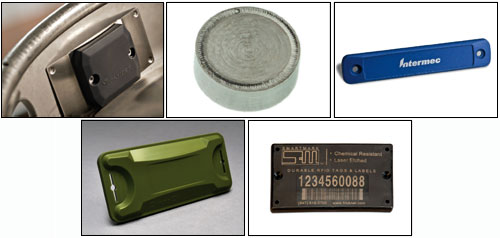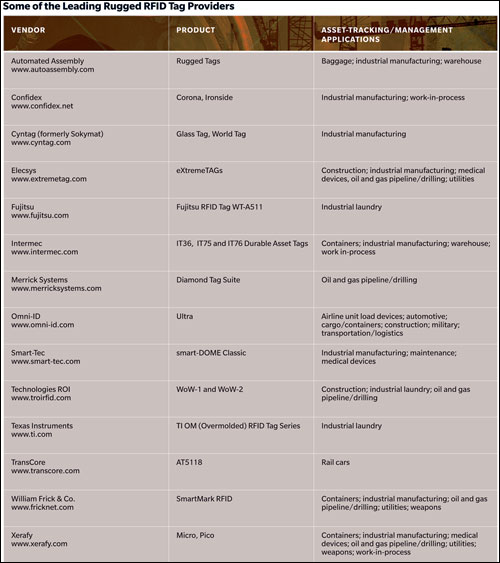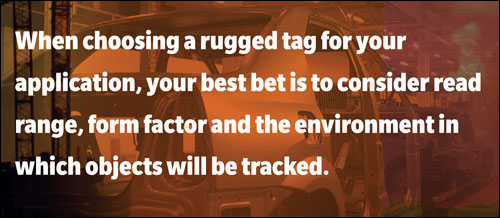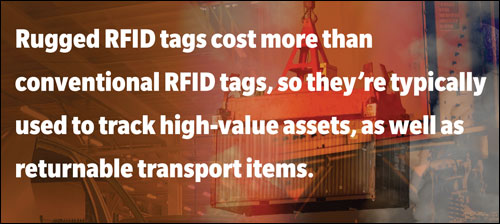Aug 01, 2010You've heard of extreme sports, fitness, music, even makeovers. Now you can add extreme RFID to the list. Today, some RFID tags are designed to withstand extreme temperatures, harsh chemicals, pounding pressure, dust, rain, shock and other hazardous environmental conditions. And these "rugged" tags are helping companies in a wide range of industries—including chemical, construction, industrial laundry, manufacturing, oil and gas, utility and waste management—achieve benefits that just a few years ago seemed impossible.
Given today's extreme market competition, it's not surprising that many manufacturers claim the "rugged" title for their RFID tags. But for this report, a tag is rugged only if it is durable in harsh environments where assets, often containing metal or liquid, require tracking.
"A rugged tag can withstand shock, rain, dust, light immunity, oil and chemical resistance, solar tolerance, humidity [and/or] extreme temperatures," says Neelima Sagar, a Frost & Sullivan senior research analyst. "It can handle hazardous chemicals and can withstand temperatures of minus 50 degrees to 250 degrees Fahrenheit [minus 10 degrees to 121 degrees Celsius]." Some tags are designed to tolerate even more heat. Tag packaging also may be optimized for mechanical robustness, Sagar notes, so each tag can be reused hundreds of times in physically demanding environments, or be embedded in the asset for the life of the equipment.
To choose a rugged tag that's right for your company, consider the key issues we discuss below. Then check the table on page 31 for a list of RFID vendors that make rugged tags for your application.
Rough Applications
First, let's look at some RFID applications that demand rugged tags, and the environments in which they must survive to do their jobs.
Beverage kegs: Makers of beer, soda and other beverages store their goods in kegs that must be washed often in extremely hot water or steam-cleaned, then dried in hot air to kill bacteria. Identifying kegs with hardy RFID tags enables companies to record information for legal, regulatory, financial or other business reasons. Ringnes, a Norwegian beverage manufacturer, tracks its reusable containers as they're shipped out from and back to its distribution center in Oslo. New Belgium Brewing Co. tracks the aluminum-and-steel kegs it uses to distribute the beer produced at its Fort Collins, Colo., brewery, to determine when kegs are filled, shipped, received and returned for servicing or refilling.
Industrial laundry: Hotels, hospitals and uniform services track garments, tablecloths, sheets and towels to monitor inventory and make laundering or dry cleaning these items more efficient. RFID tags must be able to sustain repeated exposure to high temperatures and/or chemicals. The Fairmont Pacific Rim Hotel, in Vancouver, B.C., tracks more than 8,500 items weekly as they are laundered and returned. St. Olavs Hospital, in Trondheim, Norway, uses an RFID-based uniform-tracking system to save inventory space, labor and operational costs.

Manufacturing work-in-process: Industrial manufacturing often requires components to be submersed in chemical baths, exposed to high-heat paint applications or subjected to caustic cleaning solutions. The tough RFID tags that can survive these processes enable companies to track the components and subsystems as they move through various assembly lines. Volvo Cars, in Ghent, Belgium, the company's largest manufacturing plant outside Sweden, tracks car bodies throughout the manufacturing process.
Oil and gas equipment: RFID tags can store critical information about the lifecycles of pipeline components, but they must be able to withstand exposure to high pressure, rotation, heat, abrasion and chemicals. Mobile drilling assets often must be tracked in wet, muddy environments that undergo vast temperature fluctuations. Nabors Canada, a land-drilling product and services provider, tags assets to manage and maintain its equipment. Saipem, an Italian engineering and construction company for subsea oil and gas production, tracks its large equipment, including drilling rigs and cranes at production sites, to improve safety and reduce waste and delays.
Railroad cars: RFID tags used for identification and/or maintenance of train cars endure exposure to wind, rain and sun, as well as constant vibration and potential impact. Spoornet, a South African provider of rail freight services and the region's largest rail operator, tracks its freight railcars to keep tabs on their location. Swedish steelmaker SSAB tracks some 400 railcars used to transport steel slabs between its facilities, to ensure each car is loaded with the correct materials, and to identify the cars' locations.
Utility monitoring: Telephone poles, fire hydrants, transformers, water system valves and manhole covers are among the assets that undergo regular inspections for maintenance and/or security, and require tracking with rugged RFID tags to withstand exposure and impact. Berliner Wasserbetriebe, the utility company that provides the city of Berlin and its surrounding areas with drinking water and sewage services, tracks 62,000 pieces of machinery and equipment to simplify the inventory process and keep close tabs on the condition and location of its capital goods.
Click here to view a larger version of the above table.
Performance Under Stress
When choosing a rugged tag for your application, your best bet is to consider read range, form factor and the environment in which objects will be tracked.
Your application will determine the distance from which you need to identify, track and manage assets. For most applications, passive ultrahigh-frequency (UHF) tags will do the job. They operate from 856 MHz to 960 MHz, typically conform to the EPC Gen 2 air-interface protocol and generally provide a read range of up to 30 feet (10 meters). High-frequency (HF) passive tags that operate at 13.56 MHz usually have a read range of up to 3 feet (1 meter). Some applications may require additional capabilities that active or battery-assisted RFID tags can provide, such as a longer read range or more specific location identification. These tags also can be used to monitor environmental conditions. But active tags may be impractical for some extreme circumstances in which rugged tags must operate, since they require batteries that must be charged or replaced.
The performance of rugged UHF tags is not a significant concern anymore, says Michael J. Liard, RFID program director at ABI Research. "The new integrated circuits from Alien Technology, Impinj and NXP Semiconductors are better than several years ago, so they enable faster read speeds," he says. "The core foundation of the technology is solid, robust and continues to improve and demonstrate viability. Where you start getting into interesting areas is size, shape and form: Is it flat enough? Is it too big? If it needs to be bolted on, how small can we go with certain types of tags?"
Omni-ID says its recently debuted UHF Ultra, which features a rugged polycarbonate case for all-weather exposure, is the first passive tag with an on-metal RFID range of more than 100 feet (30 meters).
Confidex says its UHF SteelWING tag offers a read range of up to 10 meters (32 feet) and has an adhesive backing so you can attach it directly to a metal surface, to enhance performance.
Elecsys, which acquired MBBS last year, offers proprietary tags that operate at frequencies as low as 125 kHz, which can be affixed to metal objects.
For many applications, rugged tags can be attached with adhesives—if the environment is cool and dry, and the surface is flat. But heat and moisture can break down adhesive properties. Also, if you're tracking assets in extreme high temperatures, the conventional connection for RFID inlays—conductive adhesive—may shift and break, says John Poplawski, Frick & Co.'s product development manager. That's not an issue with the company's UHF MS-HE16 tag, he says, because the chip and antenna are soldered together. The tag is designed for high-impact and high-temperature environments—from 300 degrees to 650 degrees Fahrenheit (149 degrees to 343 degrees Celsius) for up to two hours—to track molds or other high-value parts and tools used in processes such as injection molding or painting.
Note that some apps require two or more rugged tags to track a single asset. It can be difficult to read the tags on drilling pipes stacked on a rig or in a yard, for example, or on assets buried in mud. The use of multiple tags helps ensure that at least one tag will be oriented to the reader so the asset can be identified.
The Price of Durability
Be prepared to pay more for rugged RFID tags than for conventional RFID tags. "Typically, when you see a ruggedized tag being deployed, the cost of the asset is quite significant," ABI's Liard says. One exception is in tracking RTIs. While an RTI may not be a high-value item, replacing lost or misplaced racks, totes and pallets can become costly. The auto industry, for example, spends more than $750 million a year to replace RTIs, according to AMR Research.
Today, a simple passive tag may cost as little as 20 cents while a rugged tag could cost $10 to $20, depending on memory, packaging and other features. It's tough to nail down the cost of rugged tags, because so much more goes into the equation—a lot of work and materials are involved in producing rugged tags, Liard says, including the durable plastic or other housing that keeps them hermetically sealed, type of attachment required, manufacturing method and amount of testing. Active and battery-assisted tags are more expensive than passive tags, especially if they support sensors or other monitoring devices. Additional factors include the volume of tags you need and whether your purchase is part of a broader package. You'll likely work with a systems integrator to deploy an entire RFID solution, including hardware, software and services.
One thing is clear: If you're ready to take RFID to the extreme, there's a rugged tag tough enough to help you get there.





